Photovoltaics, Solar systems and Delock DL4
This information article is about the issue of solar energy in general and, especially, Delock's contribution to accessories for photovoltaic systems. A short view of the history of photovoltaic (PV) technology serves as an introduction. Then we have a look at the elements of a solar system, show the specialties of the Delock DL4 connector, look at the differences in solar cables, and what you have to consider when choosing it. At the end, some Delock product examples are shown.

Introduction: A short look at the history of photovoltaics
Electricity, made from solar energy, belongs to the so-called Renewable Energies. Besides sun power, energy from water, wind, and biogas counts also to Renewable Energies. The path from solar power to usable electricity succeeds with photovoltaics (PV).
The beginnings of the solar technology
The history of PV technology is not as young as many might think. It began as early as 1839 with the discovery of the photoelectric effect by the French physicist Edmond Becquerel. In 1954, the first functioning silicon-based solar cell was presented to the public. Four years later, in 1958, there was the first technical use of PV elements with the Vanguard1 satellite. For a long time, the energy supply of satellites remained the main field of application for photovoltaics; it was thus a military one.
The German EEG and how it continued
Since the end of 1980, intensive research has been conducted on PV in Germany, the USA, and Japan. With the introduction of the Renewable Energies Act (EEG) in 2000, the actual start of the civil use of PV in Germany can be dated. Government grants and subsidies were intended to drive the conversion away from fossil fuels and towards renewable energies. Since then, the EEG has undergone many amendments. Other countries have also created similar programs to strengthen renewable energies. Currently, the expansion of non-fossil energy sources is more important than ever before.
And today?
In the years since the EEG came firstly into force, a lot of things have happened in the area of private use of photovoltaics. As a result of steady changes in the law, the main motivating force for private people of the feed-in compensation at the beginning of the EEG got into the background. For this, self-consumption is now the top priority for homeowners and companies.
Electricity from the own roof is not only competitive but partly less expensive than purchased from the energy company. The ability to keep electricity available in large storage units for use as needed has led to the development of a completely new market for PV system accessories, independent of government support and subsidies.
Elements of a photovoltaic system
A PV system is made up of the following elements: The photovoltaic modules themselves (which consist of solar cells), the inverter, the battery for storage, and the point for feeding into the public grid. Solar cables connect the system.
Solar cells
Every PV module consists of several solar cells, regularly 36 to 72. There are various types of solar cells that differ by their production mode, their look, and their performance: Monocrystalline solar cells are made of pure silicon, polycrystalline solar cells are made of many individual silicon crystals, and thin-film solar cells. The latter are made of amorphous silicon and are still rarely used.
Monocrystalline solar cells require the smallest area, as they have the highest efficiency. They are comparatively more expensive, but their purchase is worthwhile for smaller roof areas, as they produce significantly more electricity. Polycrystalline solar cells are cheaper and less efficient compared to monocrystalline ones, so they need more surface area. Thin-film solar cells are flexible in terms of where you can use them because of their thinness. So far, however, they are still much less efficient than mono- or polycrystalline cells and require a lot of surface area.
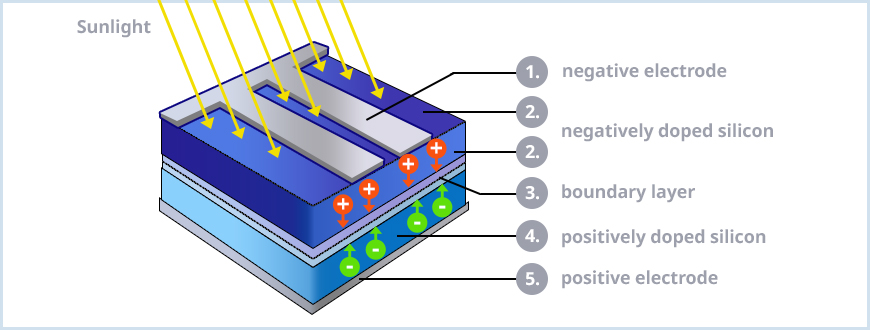
Solar cables
Electrical lines or solar cables connect all elements of a PV system, be it on a private rooftop, balcony, or an industrial solar field. Solar cables are initially there to pass on the current in different forms: Direct or alternating current in various voltages. Secondly, solar cables have the task of overcoming distances.
PV systems in private households or companies are usually mounted on the roof. The associated components such as inverters or batteries, on the other hand, are set up in the cellar or attic, and the cables connect the system together. Finally, solar cables are used to connect the PV system to the public grid, and cable lengths of up to 50 meters are not uncommon.
The Delock DL4 Connector
How is the DL4 connector constructed?
The DL4 connector consists of two parts comparable to a socket. There is the "male" part, the plug, and the "female" part, the box. The plug lies in a small bowl, whereas the box lies in an elongated probe. The box has two little holding fingers on its sides, which snap into place while connecting with the plug and make a strong connection.
DL4 connectors, like all DL4 solar cables, are double-insulated and have a weather-resistant covering. They have protection class IP67, which means they are dustproof and waterproof. The polarity of the connectors is clearly visible as they are marked with the plus or minus pole.
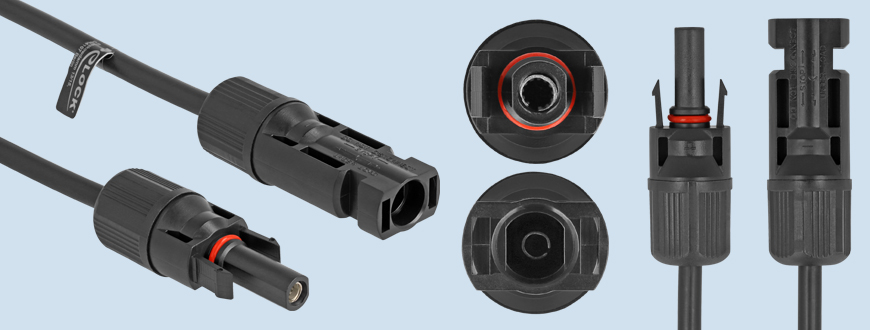
Where and how can you use the DL4 connector?
DL4 connectors can be used everywhere where solar cables with cross-sections of 4 mm², 6 mm², or 10 mm² are applied. Solar cables in these variations are generally used for any kind of photovoltaic system: May it be the big dimensioned industrial facility to produce net electricity, be it the solar panel at the rooftop of a private living house or the increasingly popular balcony power plant for flat tenants or owners.
Consumers are also investing more and more in mobile equipment, e.g. foldable solar panels and the corresponding power station, for example for camping. Whatever the type of PV system, cables with cross-sections of 4 mm² are used most frequently. This means that DL4 connectors, which are compatible with this, are also most frequently in demand.
As mentioned above, the solar cables, connected by the appropriate connectors, deliver the electricity from the solar panels to the inverters or distribution enclosures. An inverter transforms the direct current produced in the solar modules to usable alternating current. For example, the current can be transformed into a main voltage of 230 V AC voltage to supply e. g. a residential house.
How can you mount the DL4 connector?
DL4 connectors can be plugged together by hand. This makes it easier to set up a private or company network and saves a lot of time during cabling. The connection is secure and durable, as it is literally locked by the snap-in function. Accidental loosening is impossible, as the plug connection can only be disconnected again with special tools.
Which products does Delock offer in the area of PV accessories?
Delock offers the the most frequently used cables with 4 mm² cable cross-section in a length of up to 10 meters. Also in stock are splitter cables with 4 mm² cable cross-section with up to 1 to 4 plugs / sockets, connectors with up to 1 to 4 plugs / sockets, connectors for crimping, and tools for mounting and re-mounting. The DL4 product portfolio is constantly being expanded. In the image below, you can see some examples of Delock diversity. In the caption, the items are linked. At the end of this information page, the product examples are presented in more detail and also linked.
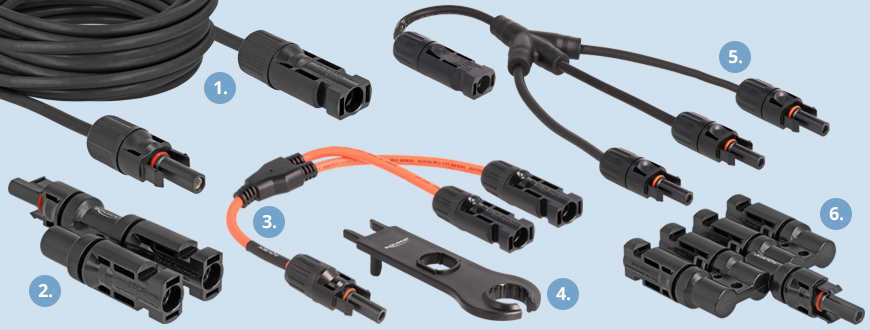
Exkursus: Which cable for which photovoltaic system?
Photovoltaic systems are so individual like the intended purpose of each. The conducting lines within an electricity generating system differ likewise the kinds or variants of cables. The system is confectioned according to the specific requirements and conditions. To achieve optimum performance, the ideal cable type should be used. The two decisive characteristics are explained below.
Cable length and cable cross-section
Two characteristics are most important for defining the "right" solar cable in each case: firstly, the cable length, and secondly, the cross-section. Both characteristics influence how easily the current is conducted through the cable and how big the loss is during transport. To put it simply, the more "space" there is in the cable - the higher the cross-section - the more current can flow through it. At the same time, the loss is lower because the higher the cross-section, the less current can "touch" the cross-section surfaces. By "touching", energy is "lost" in the material.
In addition, the longer the cable, the more current is lost. Or, the longer the distance the current is conducted, the higher the loss. All in all, it can be reduced to the formula: The more current, over the longer distances, that has to be transported, the thicker the cable should be. However, always using a cable with the largest cross-section "for safety's sake" is not a solution either. The thicker the cable, the more expensive it is. Therefore, the best possible cost-benefit analysis should be carried out, or the best compromise should be found depending on the requirements, which provides optimal functionality at optimized costs.
What does it practically mean?
For the private consumer who equips his house with solar modules, a cable system with a 4 mm², possibly also a 6 mm² cable cross-section, will usually make sense. Higher cross-sections, e. g. 10 mm², are more likely to be used in industrial installations where entire fields are covered with solar panels.
Product examples Delock DL4
All Delock DL4 items are compatible with MC4, TS4 and QC4!

Item 88231
DL4 Solar Cable 4 mm² male to female | 10 m
- Cable cross-section: ca. 4 mm²
- Voltage: max. 600 V
- Operating temperature: -40 °C ~ 90 °C
- Also in 1, 2, 3 and 5 m
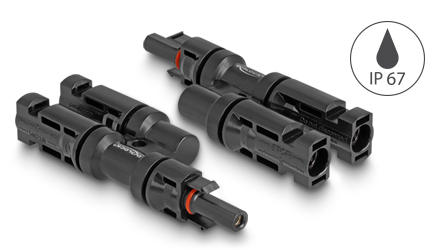
Item 60023
DL4 Solar Connektor 1 x female to 2 x male
- Cable cross-section: ca. 2.5, 4, 6 mm²
- Voltage: max. 1000 V
- Operating temperature: -40 °C ~ 85 °C
- Dimensions (LxWxH): ca. 10.4 x 3.9 x 1.8 cm
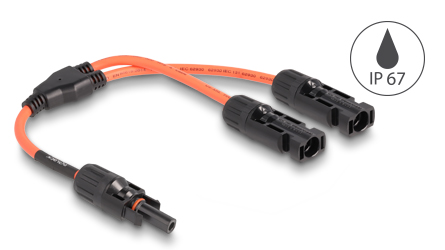
Item 88223
DL4 Solar Splitter Cable 1 x female to 2 x male
- Cable cross-section ca. 4 mm²
- Voltage: max. 1000 V
- Operating temperature: -40 °C ~ 85 °C
- Length incl. connectors: ca. 30 cm
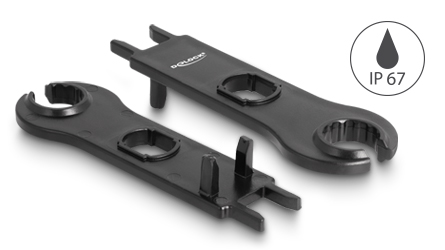
Item 60030
Tool for DL4 Cables + Connectors| 2 pcs
- Multi-functional
- Material: plastic
- Round handle for cable gland
- Dimensions (LxWxH): ca. 11.8 x 2.9 x 1.5 cm
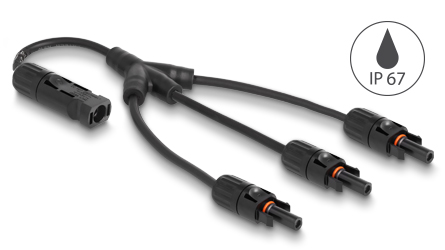
Item 88224
DL4 Solar Splitter Cable 1 x male to 3 x female
- Cable cross-section: ca. 4 mm²
- Voltage: max. 1000 V
- Operating temperature: -40 °C ~ 85 °C
- Length incl. connectors: ca. 35 cm
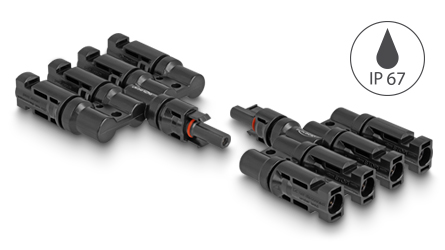
Item 60027
DL4 Solar Connector 1 x female to 4 x male
- Cable cross-section: ca. 2.5, 4, 6 mm²
- Voltage: max. 1000 V
- Operating temperature: -40 °C ~ 85 °C
- Dimensions (LxWxH): ca. 10.4 x 3.9 x 1.8 cm
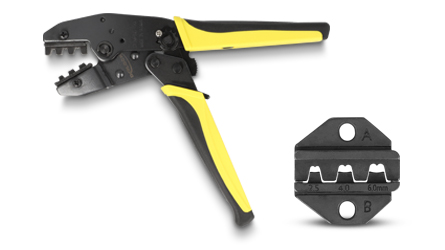
Item 90546
Crimping Tool for DL4 plug 2.5 - 6 mm²
- Metal pliers with plastic handles and lock
- Suitable cables: AWG 10 - 13
- Suitable connectors: DL4 plug 2.5 - 6 mm²
- Dimensions (LxWxH): ca. 218 x 60 x 17 mm
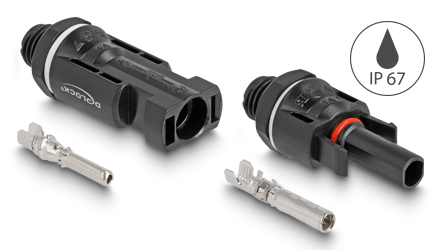
Item 60028
DL4 Solar Connectors for crimping| 2 pcs
- 1 x DL4 male / 1 x DL4 female
- Voltage: max. 1000 V
- Operating temperature: -40 °C ~ 90 °C
- Cable cross-section: ca. 4 mm²
